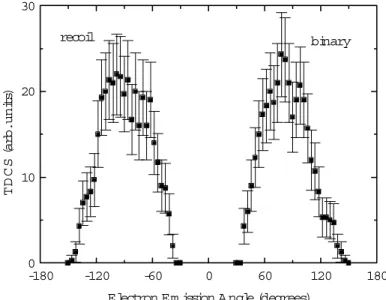Brazilian Journal of Physics, vol. 36, no. 2B, June, 2006 522
Differential Ionization Studies for Positron Impact*
R. D. DuBois, O. G. de Lucio, and J. Gavin University of Missouri-Rolla, Rolla, MO 65409 USA
Received on 29 July, 2005
Recent studies of differential ionization by positron impact being performed at the University of Missouri-Rolla are described. Recoil ion-scattered positron and recoil ion-scattered positron-ejected electron coincidences are measured to provide doubly and triply differential ionization data (DDCS and TDCS) for e+- Ar collisions.
The DDCS and TDCS studies are for 750 and 200 eV impact respectively. For the TDCS studies the positron scattering angles are between approximately±5◦and electrons ejected with energies less than 15 eV and angles between 90◦±50◦with respect to the beam direction are detected. Examples of TDCS data for the scattered
positron and the ejected electron are presented.
Keywords: Positrons; Ionizations; Differential
I. INTRODUCTION
Data for ionizing interactions between particles and antipar-ticles can be compared to provide information about known atomic processes or about unexplored regimes of physics. For example, charge and mass effects on the interaction dynam-ics and the influence of electron exchange can be studied by comparing results obtained for electron and positron impact, or positron impact ionization can be used to study ultrainelas-tic collisions where the projectile transfers all of its energy to the target. For these purposes, highly differential experimen-tal data such as that provided by e,2e type experiments are needed since they provide extremely sensitive tests of theoret-ical models.
Numerous theoretical predictions are available for positron impact, e.g., either quantal calculations such as those pro-vided by Sharma and Srivastava [1] and Brauner, Briggs and Klar [2]. For antiproton impact, the classical trajectory Monte Carlo calculations of Wood et al. [3] are available. But, on the experimental side only a limited number of differential studies exist for positron impact. This is because the beam intensities that can be obtained are extremely weak as compared to those for electron beams. In spite of this, a few ground breaking studies have been performed. For example, doubly differen-tial electron emission resulting from positron impact has been measured by Schmitt et al. [4] and K¨ov´er et al. [5], [6]. In the late 90’s, more detailed information became available when K¨ov´er and Laricchia measured the first triply differential cross sections for positron impact [7], [8]. They studied zero degree electron emission. To date, no experimental differential data exists for antiproton impact.
II. PRESENT WORK
This paper describes work in progress at the University of Missouri-Rolla (UMR) where several years ago we started an experimental program to measure differential ionization cross sections for positron and electron impact. The apparatus con-sists of a22Na source and moderator for producing positron and electron beams, an electrostatic beam transport system,
and a scattering chamber containing a gas jet target and a pro-jectile energy analyzer. The electrostatic energy analyzer is equipped with a position sensitive detector which samples a range of energies and angles for forward scattered projectiles. In our first studies [9]-[11], differential energy loss for sin-gle and multiple ionization of Ar and Kr was measured for 750 eV positron impact. This was done by measuring coin-cidences between extracted target ions and forward scattered projectiles. These data represent the only differential informa-tion for multiple target ionizainforma-tion by antiparticle impact. For both targets it was found that the percentage of double ion-ization systematically increased for energy losses of 0 to∼50 eV above threshold and that the degree of double ionization was smaller for positron impact than for electron impact. For larger energy losses, the percentage of double ionization re-mained rather constant and was similar in magnitude for both positron and electron impact.
Recently we have added another position sensitive detec-tor that views electrons emitted between approximately 40◦ and 140◦along and transverse to the beam direction. The x,y positions recorded for each detected electron provide infor-mation about itsθ,φemission angles while for single ioniza-tion the electron energy can be determined from knowledge of the initial and final beam energies and the ionization poten-tial. Since we also know the scattered projectile energy and angles, recoil ion-scattered projectile-ionized electron coin-cidences provide triply differential cross section information, i.e., so-called (e,2e) measurements. Double ionization infor-mation is also obtained but in this case only the sum of the energies of the two ejected electrons is known. This corre-sponds to (e,3e-1) type measurements.
Brazilian Journal of Physics, vol. 36, no. 2B, June, 2006 523
-180 -120 -60 0 60 120 180
0 10 20 30
recoil binary
T
DCS
(
ar
b
.
uni
ts)
Electron Em ission A ngle (degrees)
FIG. 1: Triply differential electron emission data for single ionization of argon by 200 eV positrons. The positron scattering angle is approxi-mately -1 to -5◦and the electron energies are between 0 and 4 eV. The error bars are statistical uncertainties.
on these low-energy electrons still needs to be deconvoluted. Also, the calibration of the projectile energies and angles are still tentative. However, these data demonstrate that TDCS data for positron impact, such as that which has been
avail-able for electron impact since the 1960’s, are finally feasible.
*This work supported by the National Science Foundation.
[1] S. Sharma and M.K. Srivastiva, Phys. Rev. A38, 1083 (1988). [2] M. Brauner, J.S. Briggs, and H. Klar, J. Phys. B 22, 2265
(1989).
[3] C.J. Wood, C. R. Feeler, and R.E. Olson, Phys. Rev. A 56, 3701(1977).
[4] A. Schmitt, H. Cerny, H. M¨oller, R. Raith, and M. Weber, Phys. Rev. A49, R5 (1994).
[5] ´A. K¨ov´er, G. Laricchia, and M. Charlton, J. Phys. B27, 2409 (1994).
[6] ´A. K¨ov´er, R.M. Finch, M. Charlton, and G. Laricchia, J. Phys. B30, L507 (1997).
[7] ´A. K¨ov´er, K. Paludan, and G. Laricchia, J. Phys. B34, L219 (2001).
[8] ´A. K¨ov´er and G. Laricchia, Phys. Rev. Lett.80, 5309 (1998). [9] R.D. DuBois, C. Doudna, C. Lloyd, M. Kahveci, Kh. Khayyat,
Y. Zhou, and D.H. Madison, J. Phys. B34, L783 (2001). [10] A.C.F. Santos, A. Hasan, T. Yates, and R.D. DuBois, Phys. Rev.
A67, 052708 (2003).
